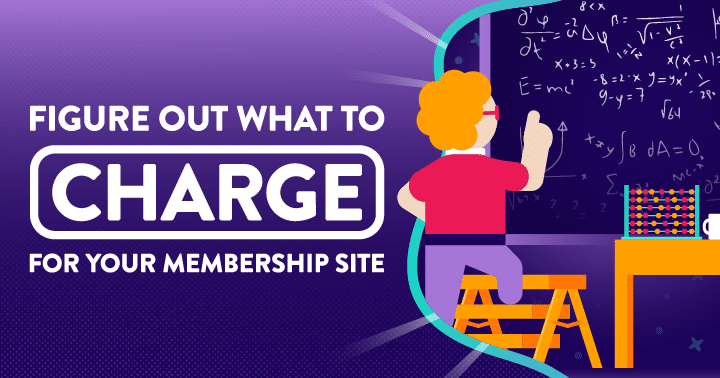Are you having a hard time deciding how much to charge for your membership site?
I feel your pain.
Hitting that “sweet spot” with your pricing strategy is no mean feat. And choosing the wrong price can have a detrimental impact on your business.
Charging too little runs the risk of lost profits, while charging too much could steer potential clients away from your membership.
Working out your membership pricing strategy is something you should put time and research into, yet over half of us still base our membership prices on a “best guess” or gut feeling.
Ideally, the cost of joining your membership shouldn’t break the bank…
But at the same time, it shouldn’t be as cheap as chips either!
You’re running a business after all… Therefore, your membership site needs to be profitable.
The first thing to consider is whether you’re going to offer recurring or non-recurring payments. We’ve actually talked about this previously in our post ‘Should you charge a one-off fee or recurring payment'.
Now, for a standard membership site, this is a no-brainer. You should be using a recurring payment model. That’s a big part of the appeal of having a membership site after all! So we’re writing this article on the basis of using the recurring payment method.
Bearing that in mind, how much should you charge for your membership? And is there an average ballpark figure you should be aiming at?
Unfortunately, there is no one-size-fits-all approach when it comes to your membership pricing. But there are four key areas to look at to help you land on a price that you and your members are happy with.
1) Your Business Financials & The Profitability of Your Membership
The first thing you need to take into consideration is your business financials.
Although you might want to make your membership as affordable as possible, you need to be careful you don’t leave yourself short.
Your membership needs to be profitable. If you’re not making enough money to cover costs, all of the hard work you’re putting into it won’t be worth your while.
Put simply: your business will have a very short lifespan if you’re not making money.
Remember. If your membership isn’t making any money, it isn’t a business. It’s a hobby.
To help ensure your profits are alive and well, you need to define your cost of member acquisition.
In other words, how much does it cost you to attract a new member?
To work this out, you’ll need to look at how much you’re spending on ads and affiliate commission, etc.
Then, think about the additional costs of running your business.
Things like sending out welcome gifts and paying guest experts to deliver material for your members, software subscriptions, paying your team/people who deliver services to you… Think of everything that comes with a price tag.
Once you know your ongoing overhead, you can calculate how much you need to make per member as a bare minimum.
From there, you can decide what sort of profit margin you want to charge on top of it.
There is a saying ‘revenue is vanity, profit is sanity, cash is king’.
So, you can work out the revenue i.e. the money coming in from your member subscription payments, plus other sources of income, if there are any.
Then work out your profit as just explained, what is left over after all expenses are paid?
Remember that you pay tax on profit so consider that when working out your actual ‘take home’ amount each month.
The absolute beauty of a membership site business model is that cash-flow should never be too much of a concern. Because people pay you, usually automatically, as per the membership terms. You’re not chasing clients for unpaid invoices and abiding by the complex payment terms of others!
Focus on the revenue and profit, and the cash should take care of itself.
2) Your Product & Offering
Members will base their decision to join your membership on the value it delivers, not the price.
The value that your actual product holds plays a huge role in determining the right membership pricing.
Your overall offering is what people are buying, so you need to ask yourself, how much is your offering worth?
Whether you charge $10 or $60 per month, you need to make sure that your price communicates the value that your membership offers to potential members.
If it delivers to them a lot of value, they’ll never question whether or not it’s worth paying the monthly cost. In fact, it’s a no-brainer for them because they know that they’re getting so much value, and long may it continue!
If your members get a lot of exclusive content, and even one-to-one time with you, you can charge a premium price for that.
But, if a lot of the membership content is self-learning and left up to them, you might have a harder time justifying a higher price tag.
Charging too little for one-to-one access and lots of great content can come up as a red flag for many people.
They won’t be calling all their friends saying they have just discovered the bargain of the century! Instead, they’ll be suspicious and wondering what’s not quite right because there’s a huge disconnect between the value and the cost.
The same thing applies to the opposite, i.e. if you’re charging a high price for something that doesn’t seem to offer a huge amount of value.
When it comes to prices, it’s often not a logical decision, it’s a psychological one.
Pricing is subjective, and while $50 a month may seem like nothing to some people, it will always be seen as too much for others.
So, make sure that you take some time to think about your product and what you’re offering. Then, adjust your prices accordingly.
3) Review Your Competitors
This is the one you’re probably least excited about!
Competitors can be a nuisance…
But you have to accept that they exist and you can learn a lot from them.
So, grab your binoculars and start scanning the market to see who else is out there competing for your member’s time, attention and money. You’ve got to look beyond other memberships and consider things like courses, private coaching sessions, books and so on.
Look at how much your competitors are charging. Then evaluate the difference in the value proposition for what they're offering compared to what your membership offers.
Do the prices add up? Or, are they charging way more than you for less value?
Of course, you should never base your pricing strategy solely on what other people are doing.
But knowing how much they charge can give you a better idea of how much your audience is willing to pay.
If you find that there is a membership that offers the same solutions as yours, but they don’t offer as much value, you can probably charge more for your membership because it’s worth more.
Make sure you communicate really clearly the value of your membership.
If the solution that your membership offers is rare and there are only a few (if any) competitors offering the same thing, you can charge a higher premium for your site.
On the other hand, if there are tons of books, courses, and memberships offering lots of free content and so on, you might need to consider adjusting your pricing.
However, that’s not to say that you should ever compete on price.
Competing on price quickly becomes a race to the bottom.
It doesn’t matter how low your membership pricing is because there’s always going to be someone who will try to undercut you.
Your membership needs to be profitable, so don’t price yourself OUT of business!
4) Consider Your Market & Your Audience Profile
Finally, you need to consider your market and determine the profile of your audience.
Their financial situation and level of disposable income will be a huge factor in whether or not they can afford and want to pay for your membership.
Think about how your membership compares to their other financial obligations in terms of importance.
Is your membership more important than their monthly phone bill, for example?
Probably not.
If you run a B2C membership, you might find that you’re a little lower on the priority scale.
This is because B2C members have a lot to consider and when it comes to budgeting. Your membership is up against things like utilities, the cable bill, groceries, Netflix, and everything in-between.
The bad news is that when it comes to cutting back on costs, your membership may be one of the first things to go when it comes to tightening their purse strings.
This is why it’s so important to understand your market inside and out.
You’ll also need to consider if there is a financial barrier to entry that comes with your membership.
So, if you’re teaching people to become better photographers, for example, there’s a financial barrier that comes with that hobby (or profession), in the first place.
Members will need to hand over the big bucks to pay for photography equipment, such as the camera, tripod, lens’ and so on.
Expensive hobbies like this usually demand a higher level of disposable income.
On the bright side, you can get away with charging slightly more for your membership, because spending money on their hobby is nothing new to them.
The opposite would be a membership for runners.
There is almost no barrier to entry to becoming a runner, apart from buying some running shoes! So members may not necessarily have the mindset to join what they perceive to be an expensive membership for their low-cost hobby.
How much should you charge for your membership?
Now that we’ve gone over everything you need to consider when figuring out your membership pricing, it’s time to get into specifics.
According to the latest Online Membership Industry Report:
- 28.7% of business to business (B2B) memberships charge between $25-49 per month, with 42.4% charging $50-99.
- 48.6% of business to consumer (B2C) memberships charge $25-$49 per month, with 28.9% charging less than $25 per month. Only 17.3% charge more than $49 per month.
It’s also interesting to note that higher price doesn’t always equate to higher revenue. The data shows that memberships charging $50-99 per month actually make less money than those charging $25-49.
Like with most things in life, there are exceptions, and these prices are just to give you a general idea of things.
The price of your membership will depend on your business, product, competitors and your market. You might start an initial low launch price and then increase the price towards the end of your launch window, which is fine.
Choose a price that allows you to maintain your membership without breaking the bank.
Remember that above all else, this is your business, and you need it to be profitable.
So, in summary…
- Look at what your competitors are charging and how your product compares.
- Work out the value that your product has for your member.
- Survey your audience and see what price range they would be willing to pay.
- Think about where you want to position yourself in the marketplace. Are you hoping to reach as many people as possible, or to be an exclusive high-end option?
- Consider the amount of 1-2-1 or group support you’re offering. You can typically charge higher if your offering includes hands-on support.
- Work out how many members you would like and how much you want to earn. Then, determine the fee needed to achieve that. (e.g. if you want to make $1000 a month and have 50 members, you would need to charge $20 a month. You can also reverse this to see how many members you need. E.g. you want to charge $20 and earn $2000, so you need 100 members.)
You should now be in a better position to determine the best pricing for your membership…
Without the guesswork!





